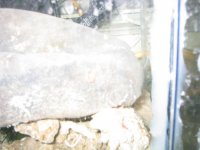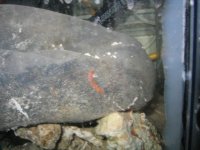You are using an out of date browser. It may not display this or other websites correctly.
You should upgrade or use an alternative browser.
You should upgrade or use an alternative browser.
Found worm. What kind
- Thread starter CHEMCHEF
- Start date
Considering there are 8,000 types of marine worms and the sharpness of the pics you posted (I mean that in the nicest way :flirt , I'd venture a guess on a bristle worm. Google yourself a better pic of one and see if it matches
, I'd venture a guess on a bristle worm. Google yourself a better pic of one and see if it matches 
He's cool...just don't hug him! :spin:
He's cool...just don't hug him! :spin:
Pedro Nuno Ferreira
Liquid Breathing
- Location
- Portugal - Vila Nova de Gaia
Hi CHEMCHEF ;-)
Further to the information given by KathyC have a look also here at Dr. Ronald Shimek website
Bristle worms also known as Fire worms are mostly beneficial, especially if you have a deep sand bed, however Hermodice carunculata is harmful for corals,
never the less it is so slow to damage them that you have enough time to remove it by waiting (at night) and catch it when it is liking the coral tissue, at which time it is defenceless to what regards escaping not regarding harming you
 ...so use gloves for the reason bellow
...so use gloves for the reason bellow
The reason for which KathyC very wisely told you to not hug it and also reason for being called Fire Worms is because of this
The presence of such worms, exception made for Hermodice carunculata for the reasons above mentioned about it, is normally a sign of good biological health in the tank.
Cheers
Pedro Nuno ;-)
Further to the information given by KathyC have a look also here at Dr. Ronald Shimek website
Bristle worms also known as Fire worms are mostly beneficial, especially if you have a deep sand bed, however Hermodice carunculata is harmful for corals,
Ron Shimek said:In contrast to the other large beneficial fire worms found in our tanks, one species decidedly presents problems for a reef aquarium. This species, Hermodice carunculata , is a fire worm species commonly found in the Caribbean, although other species in the same genus are found throughout the tropics. It is the only potential “problem” fire worm in aquaria because it eats stony corals and gorgonians in its natural habitat, but may also prey on soft corals in the aquarium. As with all fire worms, this species has no jaws to bite off chunks of food, rather it must lick them to death.
never the less it is so slow to damage them that you have enough time to remove it by waiting (at night) and catch it when it is liking the coral tissue, at which time it is defenceless to what regards escaping not regarding harming you

The reason for which KathyC very wisely told you to not hug it and also reason for being called Fire Worms is because of this
Ron Shimek said:When a predator, or an unwary aquarist, tries to pick up a fire worm, the bristles pierce its flesh, break, and release the venom, which functions as an irritant. While the irritation to humans is typically mildly irritating, it may be significantly painful in sensitive individuals. If you need to hand these worms it is best to use forceps, or where gloves.
The presence of such worms, exception made for Hermodice carunculata for the reasons above mentioned about it, is normally a sign of good biological health in the tank.
Cheers
Pedro Nuno ;-)
Last edited:
- Location
- Throggs Neck, BX
Chef, this is what you need to do. Grab a cup and a bottle of bleach. Add two cups and run before the thing kills you. Looks like a bristle to me. They are great to add to scampi's.








